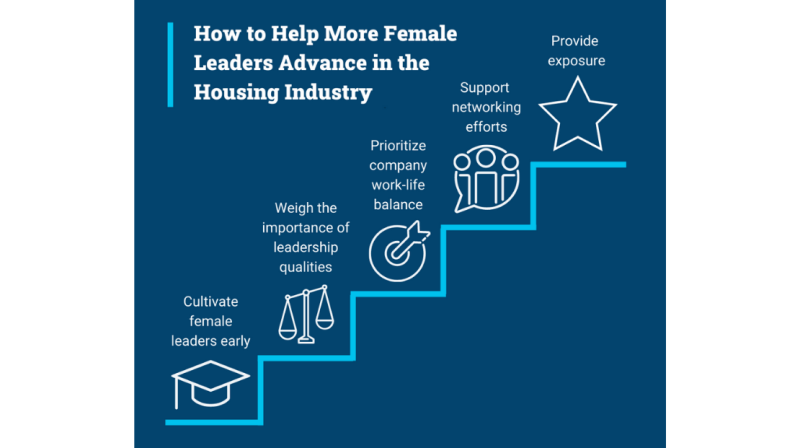Advancing Female Leaders in the Housing Industry

Men and women at financial services companies often start out in fairly equal numbers. But men still dominate leadership positions, holding over 80% of roles with profit-and-loss responsibility. The consequences of this disparity hurt both women and the future of the industry, since numerous studies highlight that companies with gender diverse executive teams see greater profits and attract better talent.
Both men and women benefit from mentors and sponsors as they advance their careers, whether their supporters are men or women. But the raw numbers tell us that with men dominating executive roles in financial services, their advocacy and inclusion is critical in getting women into the higher ranks.
Why the Housing Industry Needs More Women at the Top
The empirical data makes a strong case for why women should be in more leadership roles. A recent McKinsey report(Opens a new window) found that companies “in the top-quartile for gender diversity on executive teams were 21% more likely to outperform on profitability and 27% more likely to have superior value creation.”
Given that women account for less than 2% of CEOs and fewer than 20% of executive board members in financial services companies worldwide, according to an International Monetary Fund (IMF) report,(Opens a new window) male allies are essential in helping to close this gap.
A closer look at the traditional gender roles within the mortgage and housing industries might tell us how we got here. Mortgage lending in particular is a sales-driven business model, with men traditionally seeking out the production-oriented roles and women gravitating toward operations, quality control, and customer service—roles demanding problem solving and attention to detail, but typically not a path to the top positions.
Since the financial collapse of 2007, the industry has shifted from production quantity to production quality, with more attention on superior customer service, professionalism, open communication, and on strong business and capital markets experience. This increased focus on quality may already be removing some barriers for women who’ve proven their worth in these competencies. But progress to the top is still too incremental, and without the men at the top taking deliberate action to advance women, the industry risks losing them, their skills, and the benefits that come from their leadership.
How Men Can Help Remove Barriers
While women are vastly underrepresented in the upper ranks of the industry, they account for over half of the entry-level workforce, according to the IMF study. This poses the question of what’s disrupting their career paths. A forthcoming Harvard Report sponsored by Freddie Mac points out that many women are either opting out of the jobs that tend to feed into the higher-level positions or out of the industry entirely.
Examining the reasons behind these obstacles—even those that seem self-imposed on the surface—can provide a roadmap for actions men in leadership roles can take.

Source: Harvard Report sponsored by Freddie Mac
According to the Harvard report:
- Give high-potential women assignments and roles that give them more exposure within the organization.
- Make sure women know the paths that lead to leadership roles—even if it means taking a lateral move—and then help them network and build the appropriate contacts.
- Start early—hire women interns and at the entry-level and give them access to a mentor or sponsor, whether male or female, to help identify those with leadership potential.
- If your company doesn’t already have one, create a formal mentorship program and encourage men to join, or find ways to help mentors and sponsors connect organically in settings such as luncheons and webinars.
- Don’t base promotions exclusively on task performance—take into account qualities such as the ability to develop relationships and motivate others.
- Keep improving work-life balance within your company, particularly programs that help working mothers balance home life if they opt to stay in the workforce, and reentry programs to help them pick up where they left off if they decide to take time off.
Promote Women Like the Future Depends on It
A significant talent shortage could be looming for the financial services sector—a 2018 study by Korn Ferry projects that a lack of qualified workers could result in $435 billion in unrealized economic output in the U.S. by 2030.
Competition for strong talent could become fierce, and companies of all sizes should be opening doors for women into leadership and attracting young women into the industry—particularly since now over half of all college graduates are female.
Keep in mind, female senior leadership increases threefold for each woman added to the executive ranks, according to a Deloitte studypdf. The case for male leaders to recognize and act on their role in this undertaking has never been stronger.
Visit #LeadingTheWay to learn more about advancing women in the mortgage industry.